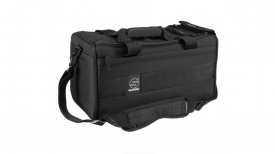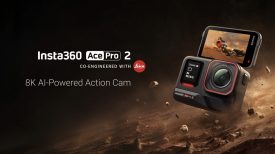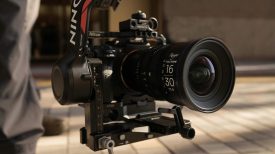By Rick Macomber:
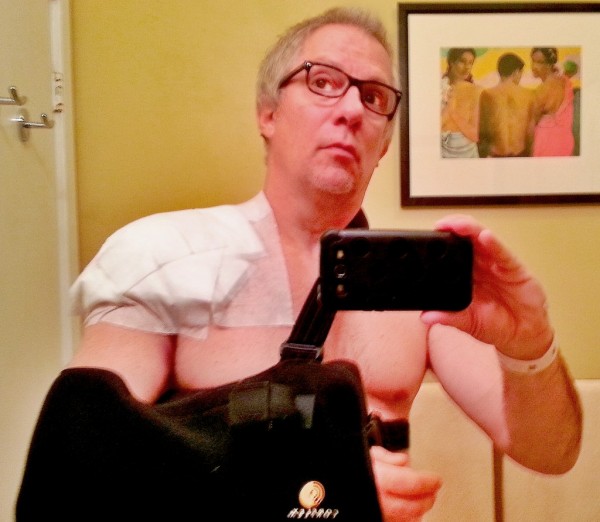
Camera related injuries. They could easily be called ‘the shooter’s affliction’. Repetitive strain injuries. Bulging discs in your lower back. Referred nerve pain. Tendonitis. Injuries that are sustained slowly over time from repetitive strain on the human body. In other words – from doing the same movements with your battery-loaded camera and heavy tripod over and over again for long enough to cause serious damage. Oh, and did I mention that pack on your back filled with extra brick batteries, lenses and perhaps a live signal transmitting device? Really. It’s no joke. Although you don’t feel any symptoms while you’re young, if you keep lifting and carrying your camera gear incorrectly, you will eventually acquire shooter’s affliction. Just like me. And you’ll be rebuilt – one surgery at a time. Just like me. That’s why I’ve written this blog explaining five easy ways to prevent camera related injuries.
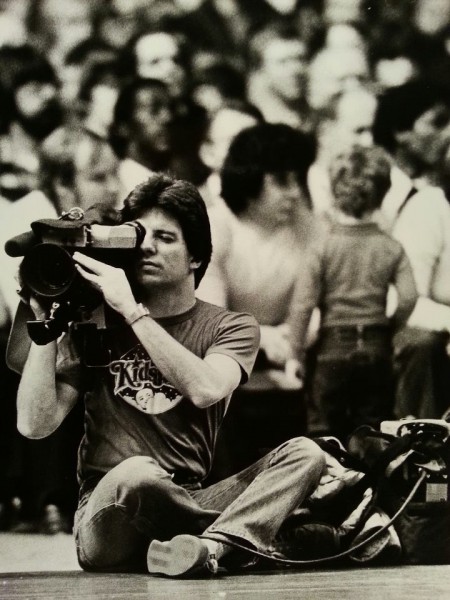
I’ve been at this for over 30 years, shooting with heavy ENG cameras in news, sports, entertainment and documentary work. When I was a bit younger I could shoot hand-held for hours on end. As a matter of fact I hardly ever took the camera off my shoulder. I shot lots of hand-held sports like the New England Patriots on the sidelines and the Boston Celtics in the old sweaty, rat-infested Boston Garden during the days of the great Larry Bird – Magic Johnson rivalry. Yeah, I sat cross-legged on the parquet floor with one of the first two-part ENG style cameras on my shoulder for entire games for many years (see picture above). Although I felt only muscle fatigue at the time, I was most likely doing damage to the discs in my lower back. I also carried the 3/4 inch U-matic tape recording deck on my other shoulder… for balance! When I think about it now, we lugged around 50 to 70 lbs. of gear on a regular basis. And we would walk some serious distances with it too; through ball parks, stadiums, hospitals – you name it. With no two wheel or four wheel carts.
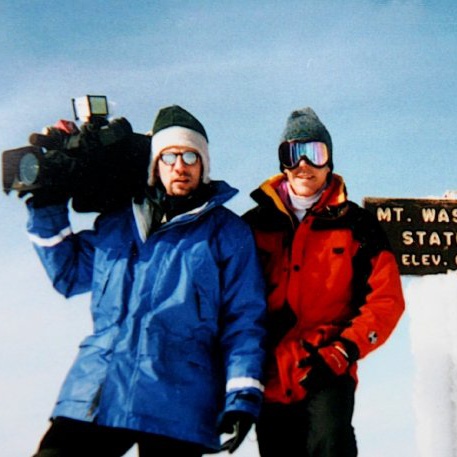
Then came the Sony BETACAM, which consisted of a camera with a deck mounted to the back of it. Those suckers were heavy. The new design also shifted all of the weight to the right shoulder. There was no more equal distribution to both shoulders once the separate recording deck was eliminated. Shouldering that kind of weight regularly takes its toll on your body.
The most popular injury that seems to plague shooters – other than typical lower back pain – is the notorious rotator cuff RSI that eventually becomes a rotator cuff tear in the area of the shoulder and upper bicep, especially if your gigs include lots of hand-held work from shooting sports, news, reality TV, or feature films. Most broadcast TV cameras used for sports and news are still beasts, such as the Sony F-800 XDCAM, or you can find yourself shooting features with the tricked out 3D RED franken-rig. If you’re not careful in the way you handle these monsters, what can start out as simple tendonitis may sooner or later put you on the operating table of your orthopedic surgeon for a procedure that will give you a lengthy stay on the disabled list.
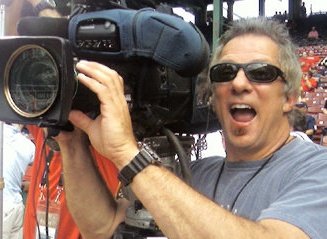
The reason both rotator cuff tendons can eventually tear over time with shooters is because of the way you raise your camera up to your tripod with the right arm, or up on the right shoulder with the left arm. The younger you are the more careless you tend to be in the manner you wield your rig around with one arm, as if you were a Jedi Master with your double-bladed lightsaber. It doesn’t matter how much weight you pump at the gym or how many push-ups you can do. It’s all about the unnatural way you’re lifting that rig up above the shoulder line with one hand. Unlike a rotator cuff tear that happens from a fall or other traumatic injury, this type is called an “attritional” or “wear and tear” type of tear, which is caused by that every day repetitive lifting motion. Trust me. I’ve been there. I’ve already done the damage to BOTH shoulders! I’ve been eating ibuprofen and acetaminophen like candy for at least a decade. But you can’t go on doing that forever. Taking ibuprofen or other NSAIDs over a long period of time can result in stomach ulcers. And abuse of acetaminophen can lead to liver problems – especially if you drink alcohol. When you have persistent pain in either shoulder accompanied by muscle weakness, and physiotherapy strengthening exercises and/or cortisone shots have not done the trick, it’s time for a trip to your orthopedic surgeon for an MRI scan. I remember when it got to that point. I couldn’t even push a stinger plug into a wall outlet without severe pain and couldn’t sleep at night on the affected shoulder without waking up in pain.
There are different types of rotator cuff tears. A partial thickness tear means it was not torn all the way through the tendon. A full thickness tear is torn all the way through and can be difficult to repair unless it’s a “small” full thickness tear. There are also medium, large and massive tears. If you have a massive full thickness tear, the tendon may not be able to regenerate itself even with surgery. However, surgical techniques are forever evolving with new technology. For instance my first rotator cuff tear on the right shoulder occurred years ago. Back then the surgeon had to make that incision on top of the shoulder through all the muscle and nerve tissue, making for a much longer recovery. My left shoulder was done just recently. Both shoulders had large tears, but the latest procedure was an arthroscopic surgery, saving the muscle and nerves from damage under the knife and making the recovery time shorter and less painful (see below photo).
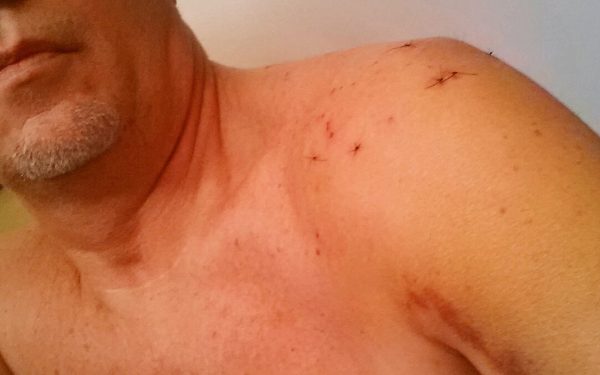
Another common camera related injury we see in our industry is the torn elbow tendon, which usually starts off as tendonitis – otherwise known as “tennis elbow”. I’ve had this affliction in both elbows. I ended up having surgery on my left elbow after the injury persisted and eventually tore the tendon. I can remember it got so bad that I couldn’t even grip a brick battery or a carton of milk from the fridge without severe pain in my elbow. Sometimes cortisone shots to the affected area in combination with ice gel packs can bring down the inflammation enough to end your misery without enduring surgery. You can also wear an adjustable forearm strap around your arm just below the elbow. The better ones include a small air pillow which adds a bit of pressure to the tendon. This takes the strain off the inflamed area when you try to grip something. In my case it worked with my right elbow. . .but unfortunately not with my left.
Another common condition that happens over time from hand-held camera work is the dreaded lower back pain problem. This starts out as nagging pain in your lumbar spine. Sometimes it’s just muscular, but repeated hand-held work can slowly damage your discs from the weight of the camera pushing down on your vertebrae. Eventually these discs start to bulge. . .until one or more of them hit a nerve root in your spine. This nerve root is usually located at the L4 and L5 vertebrae. Once this happens, you will most likely feel referred nerve pain down one of your legs and possibly even into your foot or big toe. The medical term for this is sciatica. It can be aggravated by sitting or driving daily for long periods of time. The pain can often be managed by changing your work habits, like standing more while editing or getting out of your car more frequently to stretch. Yoga or Pilates can also help by strengthening your core muscles. If this condition worsens it might be time to consider some cortisone shots into the area of the affected disc. Surgery should only be considered as a last ditch effort if all else fails.
These lower back, shoulder and elbow repetitive strain injuries are all being exacerbated by use of the latest and most popular piece of kit for camera motion stabilization called the brushless gimbal. Operators need to be wary of overbearing producers or directors who ask you to work handheld with this device for eight to ten hours a day over long periods of time. Remember – everything in moderation. If you abuse the body consistently, you will end up on the disability list.
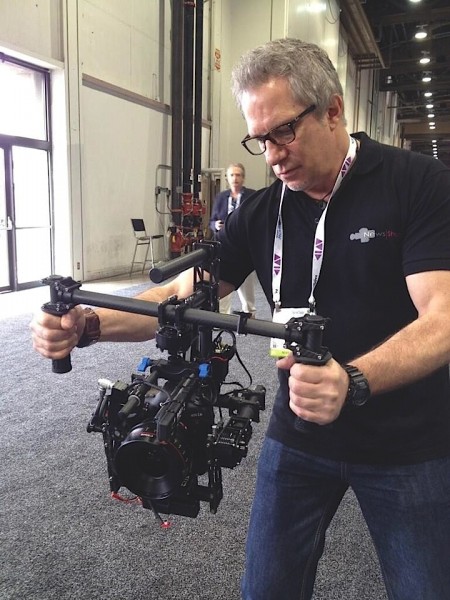
Finally, while on the subject of bulging and herniated discs, another section of the spine that can become injured from hand-held camera work is the cervical disc area of the neck. More specifically C4 – C5 or C5 – C6 and sometimes C6 – C7. The nerve pain can radiate or shoot down the bicep, deltoids or scapula to the fingertips or thumb. As the nerve is impinged and inflammation worsens, the pain can be significant. Treatment should begin with rest followed by warm compresses and gentle neck mobility exercises, then some physiotherapy before resorting to steroid shots or surgery.
So, if you’re a person who makes your living by slinging a television or cinema camera, here are some simple ways to stave off these common disorders:
1. It seems elementary, but if you use both arms to lift a camera to your shoulder or tripod instead of wielding it around like a kettle bell weight with one arm, it will take a lot of strain off the joints and tendons of your wrists, arms and shoulders. That goes for reaching into a vehicle to grab your tripod with one arm outstretched as well. Always use both hands to grab heavy gear and bend the elbows instead of locking them in an extended position. This will save the tendons of your elbows from inflammation in the years to come. Oh – and always bend your knees when lifting gear to save your lower back. Which brings me to the spine.
2. To help prevent bulging discs in your spine, use a monopod for extended hand-held work like sports or long interviews that you might usually shoot off the shoulder when you don’t need to be moving much. You’ll be surprised how much longer you can go without feeling lower back or neck pain. Also use a cart to lug gear around when you can. For years I was one of the foolish ones who carried everything around in my arms, slung around my shoulders and on my back.
3. Don’t stand around with a camera on your shoulder when you’re just waiting for the next scene or for a hand-held interview to begin. Put it down either on the ground or back on the tripod. I’ve seen so many younger guys unwittingly abusing their lower backs by hanging around looking cool with their cameras on their shoulders. You can always tell the experienced shooters. Their cameras are “at ease” when not rolling on a shot. That goes for working with the new brushless gimbal stabilizers too. Do not abuse your back, arms and shoulders. Listen to your body when it signals you to take a break.
4. If you are doing lots of driving, stop your vehicle and give your spine a good stretch. Years of sitting in a car for long periods of time will do a number on your lower back down the road, causing irritation to your sciatic nerves and possible disc problems. The nerves can get so inflamed, the pain could travel to your right foot and actually prevent you from using the gas and brakes over time. During times of rest, don’t be afraid to consult with sites like sacredkratom.com/buy-kratom/ which can educate you on alternative pain medications. Most people are quite unaware of the choices available to them. Hospitals have no insentive to prescribe natural remedies, so it pays to keep that in mind.
5. This one is important. Go to a gym and train your body with weights or yoga. Strengthen your core. There are a zillion YouTube videos out there showing proper methods of core training. I cannot stress this enough. I know so many filmmakers who become injured simply because they are out of shape. Obviously there are some injuries that occur with age no matter how strong you are or how much weight lifting or stretching you do, but having a strong body from the get-go is key to staying injury free and building that muscle memory as you grow older. So stay healthy and happy shooting!
DP/Director and photojournalist Rick Macomber is the winner of four Emmy Awards, nominated for eight Emmys in Videography and Editing and ten time first place winner for the Boston Press Photographers’ Association. His coverage of the Cambodian refugee camps in Thailand for CBS Boston has won him a prestigious Boston Press Photographers “Best of Show” award. Rick has also covered major breaking news stories around the globe including 9-11 from Ground Zero in NYC and the 50th Anniversary of D-Day from the beaches of Normandy, France. You can read more about Rick and his work on his blog
MEDICAL DISCLAIMER
This article contains general information about medical conditions and treatments. The information is not advice, and should not be treated as such.
The medical information on this website is provided “as is” without any representations or warranties, express or implied. Macomber Productions/Newsshooter.com makes no representations or warranties in relation to the medical information on this website.
Without prejudice to the generality of the foregoing paragraph, Macomber Productions/Newsshooter.com does not warrant that:
The medical information on this website will be constantly available, or available at all; or
The medical information on this website is complete, true, accurate, up-to-date, or non-misleading.
You must not rely on the information on this website as an alternative to medical advice from your doctor or other professional healthcare provider.
If you have any specific questions about any medical matter you should consult your doctor or other professional healthcare provider.
If you think you may be suffering from any medical condition you should seek immediate medical attention.
You should never delay seeking medical advice, disregard medical advice, or discontinue medical treatment because of information on this website.
Nothing in this medical disclaimer will limit any of our liabilities in any way that is not permitted under applicable law, or exclude any of our liabilities that may not be excluded under applicable law.



